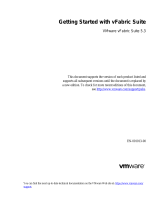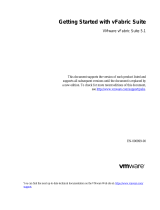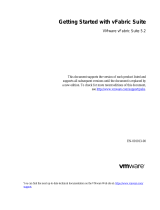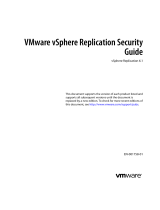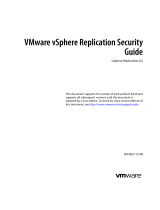Page is loading ...

VMware vFabric Data Director
Administrator and User Guide
vFabric Data Director 2.7
This document supports the version of each product listed and
supports all subsequent versions until the document is replaced
by a new edition. To check for more recent editions of this
document, see http://www.vmware.com/support/pubs.
EN- 001185-00

VMware vFabric Data Director Administrator and User Guide
2 VMware, Inc.
You can find the most up-to-date technical documentation on the VMware Web site at:
http://www.vmware.com/support/
The VMware Web site also provides the latest product updates.
If you have comments about this documentation, submit your feedback to:
Copyright
©
2013 VMware, Inc. All rights reserved. This product is protected by U.S. and international copyright and intellectual
property laws. VMware products are covered by one or more patents listed at http://www.vmware.com/go/patents.
VMware is a registered trademark or trademark of VMware, Inc. in the United States and/or other jurisdictions. All other marks
and names mentioned herein may be trademarks of their respective companies.
VMware, Inc.
3401 Hillview Ave.
Palo Alto, CA 94304
www.vmware.com

Contents
About VMware vFabric Data Director Administrator and User Guide 9
1
VMware vFabric Data Director Overview 11
Data Director System Architecture 11
VMware Data Director Components 12
Data Director User Management Modes 12
About Data Director Administration 13
Data Director Supported Databases 14
2
Managing Data Director Resources 19
Resource Management Overview 19
Resource Bundles and Resource Pools 20
Storage Resources and Data Director 21
System Resource Bundle 22
Resource Assignment 23
vSphere Resource Pools and Data Director 24
Viewing Resource Information 26
Create the System Resource Pool 26
Create the System Resource Bundle 27
Monitor Resource Usage 28
Create a Resource Pool 28
Create a Resource Bundle 29
Assign a Resource Bundle to an Organization 31
Perform Advanced Cluster Configuration 31
3
Managing Users and Roles 33
User Management Overview 34
Authenticating Users 35
Role-Based Access Control 35
Predefined Roles 36
Privileges 37
Propagation of Permissions and Roles 38
Organization Privileges and Permissions 38
Add Users to Your Organization 39
Add Roles to an Organization 39
Grant a Permission to a User 40
Modify Organization Security Settings 40
About vCenter Single Sign-On 41
Register vFabric Data Director with the vCenter Single Sign-On Service 41
Import vCenter Single Sign-On Service Users 42
Remove vCenter Single Sign-On Registration Before Uninstalling vFabric Data Director 43
VMware, Inc.
3

4
Building DBVMs and Base DB Templates 45
Database Virtual Machine OVA Files 48
Deploy a DBVM OVA File 48
Disk Configuration for DBVMs and DB Templates 49
Build an Oracle, SQL Server, or Empty Base DBVM 50
Build a MySQL Base DBVM 51
Build an Oracle and SUSE Linux Base DBVM 56
Build an Oracle DBVM with a Custom Linux Operating System 56
Requirements for the Kickstart File 60
Build a Base DBVM with a Custom Operating System 63
Create and Validate a Base DB Template 65
Database Update Configuration 68
Configure a vFabric Postgres Update Chain 69
Update an Oracle Database 70
5
Managing Organizations 77
Organization Structure 77
Operating Organizations 78
Managing Resources For Organizations 79
Managing Organization Users 80
Create a Data Director Organization 80
Bind a vCloud Director Organization to Data Director 81
6
IP Whitelists 83
Create an Organization IP Whitelist 83
Apply IP Whitelists to Databases 84
Create Custom IP Whitelists 84
7
Managing Database Groups 87
Database Group Management Overview 87
Managing Resources for Database Groups 88
Storage Reservation 89
Database Groups and Security 89
Create a Database Group 89
8
Managing Database Templates 91
Introduction to Database Templates 91
Enable a Base DB Template 92
Create a DB Parameter Group 93
Create a Resource Template 93
Modify a Resource Template 94
Create a Backup Template 95
Modify a Backup Template 96
9
Managing Databases 99
Database Lifecycle 99
Requirements for Creating Databases 101
VMware vFabric Data Director Administrator and User Guide
4 VMware, Inc.

Database Creation 102
Using Tags 116
Managing the Organization Catalog 117
Batch Operations and Scheduled Tasks 119
Updating Databases 120
Database Administration 121
10
Cloning Databases 127
Clone Types 127
Cloning Customizations 129
Clone a Database 129
Managing Post-Clone Scripts 133
Managing a Cloned Database Refresh 137
11
Managing Database Entities 141
Database Entity Management 141
SQL Management 146
12
Safeguarding Data 149
Backup Strategies 150
Backup Types 150
Backup Template Settings 152
Preconfigured Backup Templates 153
Select a Database Backup Template 153
Schedule Regular Database Backups 154
Create a Database Snapshot 155
Recover a Database from Backup 156
Import Backups 156
Recover a Database from Last State 157
Use VMware Data Recovery to Back Up Data Director 158
Database End of Life and Backups 160
Perform Point-in-time Recovery of Management Server Database 160
Add Pre-Action and Post-Action Scripts to the DBVM for Selected Agents 161
13
High Availability and Replication 163
About High Availability in Data Director 163
vPostgres Database Replication 164
14
Monitoring the Data Director Environment 167
Explore Monitoring Customization and Filtering 167
Monitoring for System Administrators 168
Monitoring for Organization Administrators 172
Explore Database Monitoring 176
Working with Alarms 177
About aurora_mon Configuration 179
aurora_mon Configuration Parameters 180
Contents
VMware, Inc. 5

15
Managing Licenses 185
License Management Overview 185
Counting Data Director Licenses 187
About Evaluation Licenses 187
Add License Keys 188
View License Information 188
View License Usage Information 189
Change the vFabric Postgres Database Usage Type 189
Remove License Keys 190
16
IP Pool Management 191
Add an IP Pool 191
Edit IP Pool 192
Delete an IP Pool 192
17
VMware vCloud Director Integration 195
Enable vCloud Director Integration in Setup 196
Enable vCloud Director Integration after Setup 196
Edit or Disable vCloud Director Integration 197
Add a vCloud Director Organization Administrator 197
18
Reconfiguring Data Director Networks 199
Change the vCenter IP Address 199
Reconfigure the Web Console Network Mapping or Network Adapter 200
Reconfigure the vCenter Network Mapping 201
Reconfigure the vCenter Network Adapter Settings 201
Reconfigure the DB Name Service Network or DB Name Service Network Adapter 202
Reconfigure the Internal Network or Internal Network Adapter Mapping 203
Verify Network Settings in Data Director 204
Reconfigure the Database Access Network Used by a Database Group 204
Modify IP Pool Settings 205
19
Managing SSL Keys and Certificates 207
Regenerate Management Server Key and Certificate 207
Import Management Server Key and Certificate 208
Edit Management Server Certificate 209
Regenerate DB Name Server Key and Certificate 209
Import DB Name Server Key and Certificate 210
Edit DB Name Server Certificate 210
Regenerate DBVM Key and Certificate 211
Import DBVM Key and Certificate 211
Edit DBVM Certificate 212
20
Data Director Troubleshooting 213
vCenter Server Stops Responding 213
Disk Usage Exceeds Acceptable Levels 214
Resource Bundles Become Unusable Because DRS Is Disabled 214
Missing Resource Pool 214
VMware vFabric Data Director Administrator and User Guide
6 VMware, Inc.

VMware vFabric Data Director Administrator and User Guide
8 VMware, Inc.

About VMware vFabric Data Director
Administrator and User Guide
The VMware vFabric Data Director Administrator and User Guide describes the features of VMware
®
vFabric Data
Director.
VMware vFabric Data Director is an enterprise class database-as-a-service (DBaaS) solution on VMware
vSphere that provides self-service lifecycle management for heterogeneous databases. The solution includes
the following features.
n
Database creation, cloning, backup, and restore.
n
Flexible, policy-based resource management.
n
Resource isolation within organizations and within databases.
n
Security policy implementation through role-based access control.
n
Database ingestion.
Self-service database lifecycle management enables administrators to create databases, manage schemas,
configure backups, perform restores, clone databases for testing and development, scale up database sizes,
and decommission databases. Administrators can assign permissions to perform these functions to others,
such as application developers, QA (test), and production engineers.
Customizable templates for database configuration and backups simplifies database creation and resource
allocation, enabling administrators to control database parameters and enforce resource allocation policies.
Administrators perform the following types of tasks.
n
Create organizations and database groups.
n
Allocate resources.
n
Create database templates.
n
Create, clone, backup and restore databases.
n
Monitor the Data Director environment.
Administrators also manage users and roles by assigning various permissions to enable users to perform
specific database management tasks.
Intended Audience
This document is for administrators any user to whom an administrator might grant database permissions.
n
System administrators use this document to learn how to manage and monitor a Data Director
environment.
n
Organization administrators use this document to learn how to manage and monitor database groups and
databases.
VMware, Inc.
9

n
Application developers use this document to learn how to create, manage and monitor databases.
n
Application developers, QA and production engineers, and others use this document to learn how to
perform functions for which they have been granted permissions.
VMware vFabric Data Director Administrator and User Guide
10 VMware, Inc.

VMware vFabric Data Director
Overview 1
VMware vFabric Data Director is a software solution that powers Database-as-a-service in your cloud. It
enables you to implement database-aware virtualization on vSphere and provides self-service lifecycle
management for heterogeneous databases.
This chapter includes the following topics:
n
“Data Director System Architecture,” on page 11
n
“VMware Data Director Components,” on page 12
n
“Data Director User Management Modes,” on page 12
n
“About Data Director Administration,” on page 13
n
“Data Director Supported Databases,” on page 14
Data Director System Architecture
vFabric Data Director automates deployment, management, and governance of thousands of databases and
enables policy-based self-service database management for application developers.
Data Director supports the following databases.
n
Oracle 11gR2 Enterprise and Standard editions.
n
Oracle 10gR2 Enterprise and Standard editions.
n
Microsoft SQL Server 2012 Enterprise and Standard editions.
n
Microsoft SQL Server 2008 R2 Enterprise and Standard editions.
n
MySQL 5.5.27
n
vFabric Postgres 9.1 and 9.2.3 a VMware vSphere optimized relational database based on PostgreSQL.
Data Director provides flexible, policy-based resource management at the system level, and isolation at the
organization and database level. Data Director system administrators can implement security policies through
role-based access control to restrict system access to authorized users. System administrators use database
templates to guarantee corporate compliance to standardization, and carry out important database lifecycle
management tasks such as provisioning, backup, snapshots, point-in-time recovery, cloning, updating,
monitoring, and so on.
Database administrators and authorized users can configure databases by using customizable parameters.
Resource and backup templates simplify database creation. After an administrator assigns appropriate
permissions, users can create databases and allocate resources to them. Users can schedule backups, perform
restores, and clone databases to use in testing and development environments. They can scale up databases
according to system needs, and decommission databases when they are no longer required.
VMware, Inc.
11

VMware Data Director Components
The Data Director hierarchy consists of organizations, each with its own discrete database groups and
databases. Currently supported databases include vFabric Postgres, Microsoft SQL Server, and Oracle.
System administrators perform management tasks at the system level, which is the top level of the hierarchy.
To edit system-level settings you must have system privileges, but having system privileges does not
automatically allow you to make changes at the other levels.
A system can contain multiple organizations, each with multiple database groups. A database group can
contain multiple databases. You can create database groups only within organizations. Databases can exist
only within database groups.
Figure 1-1. Data Director System Hierarchy
System administrators manage Data Director resources at the system and organization levels. System
administrators create resource bundles from vSphere resource pools (CPU and memory resources) and storage
and network resources, and allocate one or more resource bundles to each organization.
Organization administrators assign resources from the given resource bundles to database groups for
consumption by databases.
Data Director User Management Modes
Data Director user management modes control how users are assigned and managed among different
organizations. Data Director has two user management modes: Global mode (for enterprises) and By
Organization mode (for service providers). Global user management mode is the default.
User management mode must be set to By Organization for VMware vCloud Director integration. See
“Organization Structure,” on page 77.
By Organization user management mode has the following characteristics.
n
Organizations are set up as separate, isolated enterprises with no visibility into other organizations.
n
The Data Director system user list is not visible to organizations.
n
No organization can see another organization's user list.
n
Organization administrators send email to invite users to join their organization, or register users directly.
n
Users can navigate to the Data Director web console URL and register for an account, pending approval
from the organization administrator.
VMware vFabric Data Director Administrator and User Guide
12 VMware, Inc.

Global user management mode has the following characteristics.
n
Organizations are set up as separate departments, business units, or groups within one enterprise, such
as a corporation's HR and Finance departments.
n
All Data Director users are visible to all organizations within Data Director.
n
Organization administrators grant access to users to the organization or grant access directly from the
system user list.
n
Users can navigate to the Data Director web console URL and register for an account, pending approval
from the organization administrator.
About Data Director Administration
Data Director system administrators perform Data Director administration on the system level. Organization
administrators perform Data Director administration on the organization level.
You create the initial account for the Data Director system administrator during Data Director setup. That
system administrator creates the system resource bundle, base database virtual machines (base DBVMs), and
base database templates.
By default, users do not have roles or permissions and cannot access any organizations. Organization
administrators assign roles and permissions to users and grant them access to specific organizations.
System administrators perform system-level operations for Data Director or for an entire organization. System
administrators perform the following tasks.
Table 1-1. System-Level Operations
Operation Type Examples
Resource management operations
n
Creating and managing the system resource bundle.
n
Creating and managing resource bundles.
n
Creating and managing database virtual machines (DBVMs).
n
Managing base database templates.
n
Assigning base database templates to resource bundles.
n
Assigning resource bundles to organizations.
n
Creating and managing resource templates.
n
Creating and managing backup templates.
User and organization
management operations
n
Creating system users.
n
Creating system administrators.
n
Creating organizations.
n
Creating organization administrators.
n
Designating existing users as organization administrators.
Organization administrators perform organization-level operations within their organizations. Organization
administrators perform the following tasks.
Chapter 1 VMware vFabric Data Director Overview
VMware, Inc. 13

Table 1-2. Organization-Level Operations
Operation Type Examples
Resource management operations
n
Creating database groups.
n
Enabling base database templates in resource bundles.
n
Creating resource templates.
n
Creating backup templates.
n
Allocating resources to database groups within the organization.
User management operations
n
Creating and managing organization users.
n
Granting organization access to existing Data Director users.
n
Assigning organization roles to users in the organization.
n
Creating and managing organization roles and granting roles to
organization user.
n
Defining organization permissions and granting permissions to
organization users.
By default, Data Director system administrators do not have access to organizations. Organization
administrators have access to only their own organization. They can create organization users and can grant
access to existing Data Director users.
Data Director system administrators can create users, but only organization administrators can grant those
users access to organizations.
Data Director Supported Databases
Data Director supports self-service database provisioning and automation through a web interface and
compatible client tools and drivers.
Data Director supports the following databases.
n
“VMware vFabric Postgres Databases,” on page 15
n
“Oracle Databases,” on page 15
n
“Microsoft SQL Server Databases,” on page 15
n
“MySQL Databases,” on page 17
Database administrators and application developers administer databases within their organizations.
Database administration includes the following tasks.
n
Creating databases and allocating resources to them.
n
Cloning databases.
n
Managing database users, roles, privileges, and permissions.
n
Maintenance such as performing backups and restores.
n
Scaling up databases.
n
Updating databases.
n
Monitoring database usage and performance.
n
Monitoring database alarms.
n
Decommissioning databases.
VMware vFabric Data Director Administrator and User Guide
14 VMware, Inc.

Oracle Databases
As a system administrator, you upload, test, and manage the Oracle base database templates that organization
administrators, DBAs, and application developers use to create Oracle databases.
The recommended practice for using Oracle with Data Director is to set up a dedicated vSphere ESXi cluster
for hosting Oracle resources, including operating system, Oracle database server, and client tools. You create
Oracle base database virtual machines (DBVMs) using the dedicated Oracle resources in vSphere, then upload
the DBVMs to Data Director to use as database templates.
Data Director supports the following Oracle versions.
n
Oracle 11gR2 on SUSE, RHEL, or Oracle Linux.
n
Oracle 10gR2 on SUSE, RHEL, or Oracle Linux.
VMware vFabric Postgres Databases
Data Director provides self-service database provisioning and automation with vFabric Postgres databases.
vFabric Postgres is built on the open source Postgres database.
vFabric Postgres is compatible with pSQL and the PostgreSQL tools and client drivers. vFabric Postgres
databases are fully compliant with ACID and ANSI SQL. The ACID properties, Atomicity, Consistency,
Isolation, and Durability, guarantee that database transactions are processed reliably.
For information about the Postgres database features for Data Director, see the Using VMware vFabric Postgres
for Data Director.
Microsoft SQL Server Databases
As a Data Director system administrator you upload and manage the SQL Server base database templates that
organization administrators, DBAs, and application developers use to provision SQL Server databases.
Use SQL Server with Data Director to set up a dedicated vSphere ESXi cluster for hosting SQL Server resources,
including operating system, SQL Server database server, and client tools. You create SQL Server base database
virtual machines (DBVMs) using the dedicated SQL Server resources in vSphere, and upload the DBVMs to
Data Director to use as database templates from which you can provision SQL Server databases.
Data Director supports the following SQL Server versions.
n
SQL Server 2012 Enterprise and Standard editions.
n
SQL Server 2008 R2 Enterprise and Standard editions.
About Provisioning SQL Server Databases
Data Director supports the creation of a stand-alone SQL Server instance using the default (unnamed) instance
or a named instance. The default instance name is the same as the host name. You can have only one default
instance per virtual machine.
NOTE A SQL Server instance is either an unnamed instance or a named instance. When SQL Server is installed
as an unnamed instance, it does not require a client to specify the name of the instance to make a connection.
The client only has to know the server name. A named instance is identified by the network name of the
computer plus the instance name that you specify during installation. The client must specify both the server
name and the instance name when connecting. By default, SQL Server installs as an unnamed instance unless
you specify an instance name.
Chapter 1 VMware vFabric Data Director Overview
VMware, Inc. 15

The Data Director provisioning process prepares and configures the SQL Server software as described in the
following list.
n
The SQL Server DBVM can join an existing Windows domain during provisioning. You must provide a
Windows Active Directory credential with sufficient privileges to join the domain. If a SQL Server DBVM
joins a domain, Windows authentication is the authentication method. The user-supplied domain account
is added to the sysadmin role of the SQL Server instance.
n
If the DBVM does not join a domain, Data Director uses mixed authentication, and prompts for the SQL
Server System Administrator (SA) password.
n
No user databases are created when provisioning within Data Director.
About SQL Server Snapshot Backups
Data Director supports manually initiated, snapshot backups with SQL Server DBVMs. You cannot use
automatic, external, or point-in-time recovery (PITR) backups when using a SQL Server a DBVM.
If you create a snapshot backup of a SQL Server DBVM, then change the configuration properties of the DBVM
and try to recover from the now out-of-date (or un-synchronized) snapshot, the virtual machine may become
unstable, or the configuration values displayed in the Data Director interface for the SQL Server DBVM may
not be accurate.
Also, snapshot backups may decrease the I/O performance of a SQL Server DBVM.
For these reasons VMware recommends that you only use snapshots as a temporary backup solution, and that
you maintain them for a limited amount of time. You can use snapshot backups before performing system
maintenance, such as applying patches to the operating system or database software, or performing database
operations that may cause a loss of data. When you have successfully completed the maintenance or data
changing tasks, delete the snapshot backup.
See “Snapshot Backups,” on page 151 and “Create a Database Snapshot,” on page 155.
Data Director Support for SQL Server
You can provision new, empty SQL Server databases using Data Director. To learn more about creating a SQL
Server database, see “Create an Empty SQL Server Database,” on page 105.
The following Data Director features are not available for use with SQL Server. When managing SQL Server
databases the user interface controls for these features are not available in the Data Director administration
console.
n
Database cloning.
n
Adding databases to the organization catalog.
n
Database ingestion.
n
Use of IP whitelists.
n
Changing disk size.
n
DBVM reporting.
n
Editing database resources.
n
Adding database owners.
n
Base DB template validation.
n
Upgrading.
VMware vFabric Data Director Administrator and User Guide
16 VMware, Inc.

MySQL Databases
As a Data Director system administrator you upload and manage MySQL base database templates that
organization administrators, DBAs, and application developers use to provision MySQL databases.
Use MySQL with Data Director to set up a dedicated vSphere ESXi cluster for hosting MySQL resources,
including operating system, MySQL database server, and client tools. You create MySQL base database virtual
machines (DBVMs) using the dedicated resources in vSphere, and upload the DBVMs to Data Director to use
as database templates from which you can provision MySQL databases.
Data Director supports MySQL Community Edition 5.5.27.
Data Director Support for MySQL
The following Data Director features are not available for use with MySQL. When managing MySQL databases
the user interface controls for these features are not available in the Data Director administration console.
n
Provision a database by ingestion.
n
Schema only clone.
n
Import or regenerate SSL keys.
n
Connection string to identify a DB Name server.
n
Performance monitoring and database statistics.
n
Alarms alerting you to MySQL specific thresholds and problems.
n
Upgrading and patching.
Chapter 1 VMware vFabric Data Director Overview
VMware, Inc. 17

VMware vFabric Data Director Administrator and User Guide
18 VMware, Inc.

Managing Data Director Resources 2
System administrators manage CPU, memory, storage, and networking resources, as well as system-wide
database and backup configuration templates. Organization administrators manage resources for database
groups and for databases and enable database templates for their organizations.
This chapter includes the following topics:
n
“Resource Management Overview,” on page 19
n
“Resource Bundles and Resource Pools,” on page 20
n
“Storage Resources and Data Director,” on page 21
n
“System Resource Bundle,” on page 22
n
“Resource Assignment,” on page 23
n
“vSphere Resource Pools and Data Director,” on page 24
n
“Viewing Resource Information,” on page 26
n
“Create the System Resource Pool,” on page 26
n
“Create the System Resource Bundle,” on page 27
n
“Monitor Resource Usage,” on page 28
n
“Create a Resource Pool,” on page 28
n
“Create a Resource Bundle,” on page 29
n
“Assign a Resource Bundle to an Organization,” on page 31
n
“Perform Advanced Cluster Configuration,” on page 31
Resource Management Overview
System administrators allocate resources to organizations. These virtual resources come directly from the
physical resources of the cluster on which Data Director runs. Organization administrators assign organization
resources to database groups and databases.
A vSphere cluster consists of several ESXi hosts that provide the physical CPU and memory resources for the
databases managed by Data Director. As part of installation, you create the cluster and enable vSphere High
Availability (HA) and vSphere Distributed Resource Management (DRS) for the cluster. Data Director can take
advantage of the vSphere HA and vSphere DRS functionality because Data Director runs on top of the cluster.
See the vSphere Availability and the vSphere Resource Management documentation for details.
VMware, Inc.
19

A Data Director resource bundle includes CPU, memory, storage, and networking resources. The CPU and
memory resources come from a resource pool in the vSphere cluster. The storage and networking resources
are assigned to Data Director during installation or at a later time. Data Director includes a set of VLANs to
carry different types of network traffic.
Data Director provides the following types of resource bundles.
n
System resource bundle. Data Director system administrators create one system resource bundle at the
Data Director system level. In addition to providing virtual resources, the system resource bundle contains
the database virtual machines (DBVMs) and base database templates that support creating and
provisioning databases. See “System Resource Bundle,” on page 22.
n
Resource bundle. Data Director system administrators create one or more resource bundles to provide
operating resources to organizations.
When system administrators create an organization, they can assign virtual resources to the organization as
resource bundles. When organization administrators create a database group, they assign virtual resources to
the database group. These virtual resources are backed by the physical resources of one or more clusters.
vSphere clusters provide failover protection and support efficient use of physical resources.
System administrators can assign resources when they create an organization (see “Create a Data Director
Organization,” on page 80) or assign resources to an existing organization (see “Assign a Resource Bundle
to an Organization,” on page 31). Organization administrators can assign resources when they create a
database group or assign resources to existing database groups.
NOTE If you chose the Express installation in the Data Director Setup wizard and enabled Create defaults, a
system resource bundle and Default resource bundle is already created. A Default organization and Default
database group is also created, and the Default resource bundle is assigned to the Default organization.
To help you specify the resources associated with a database template, Data Director includes a calculator that
computes the optimum resource configuration based on the anticipated usage patterns. When you create
databases from the template, the specified resources are allocated.
Resource Bundles and Resource Pools
A resource bundle is a set of compatible IT resources for provisioning databases. To assign the appropriate
amount of resources to each organization, system administrators create resource bundles and assign them to
organizations.
System administrators specify a resource pool and storage and networking resources when they create a
resource bundle.
NOTE If you deployed Data Director using the Express installation, and selected the Create defaults option
to specify resources, a Default resource bundle is created and assigned to a Default organization.
Resource Pool
All CPU and memory resources of a resource bundle come from a vSphere
resource pool that is created in the vSphere Client with reservation equal to
limit. See “Create a Resource Pool,” on page 28.
Storage Resources
Each resource bundle includes storage resources for the operating system,
database binary, data, log, and backup storage needs for each database virtual
machine that you create. The storage resources must be visible to all hosts that
use the resource bundle.
DB Access Networks
DB Access Networks provide communication for databases. A DB Access
Network corresponds to a vSphere port group. Each network must be visible
to all hosts that use the resource bundle. DHCP or IP Pool is required. See
Chapter 16, “IP Pool Management,” on page 191
VMware vFabric Data Director Administrator and User Guide
20 VMware, Inc.
/








